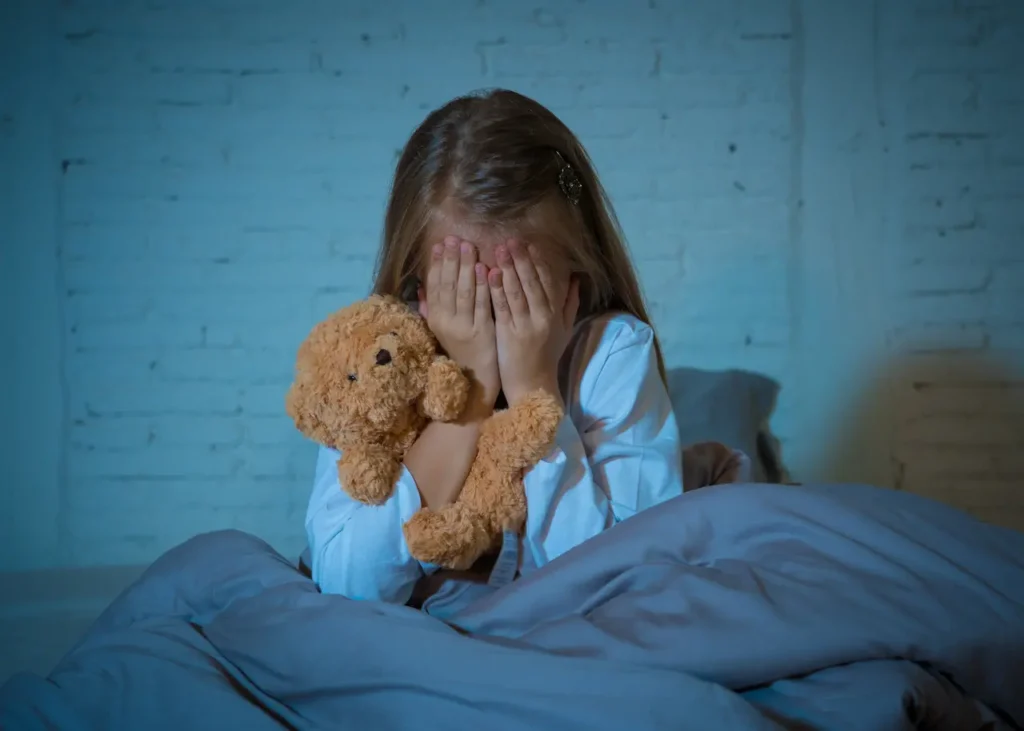Six Crucial Tips for Parents
1. What is a Night Terror?
The first two or three hours after falling asleep are usually when night terrors occur. Night terrors are most common between 4 and 12 years old, but they can occur as early as 18 months.
Night terrors differ from nightmares in many ways. Night terrors are extremely traumatizing for children and occur in the early hours of the morning. A child who is experiencing a nightmare will not wake up fully, and they will be very inconsolable. After a bad nightmare, a child will usually wake up fully and can be comforted easily by their parents.

Night terrors are not dreams at all. They are a frightened response that occurs when a child moves from the deepest non-REM state to a light REM stage.
It usually occurs smoothly, but for 5% of children, it can be a bumpy ride that triggers fear or a “night terror”.”
2. What Happens When a Child Has a Night Terror Attack?
Children who are experiencing night terrors may start talking or screaming while in a state of semi-sleep. The child will be scared and may not be able to wake up fully.
When these terrors strike, children often seem to be in a dreamlike or distressed state. They may have a rapid heartbeat, their eyes can appear glassy, and they are difficult to comfort. These kids may thrash around in bed or run as if they are being chased.
Experts at Melbourne’s Royal Children’s Hospital explain that a child experiencing a night terror will be stuck between sleeping and being awake.
They are awake enough to talk, scream, or get out of bed; however, they are sleeping in the sense that they don’t respond to parents trying to comfort them. In the morning, they usually don’t remember what happened.
3. What Causes Night Terrors in Children?
When a child’s central nervous system is over-aroused while sleeping, night terrors can occur.
Genes are often at play when it comes to children who experience night terrors. They may also have sleepwalkers or night terror sufferers within their family.
Night terrors do not always occur in association with serious trauma or psychological issues. Night terrors are a normal part of child development. However, terrors can be triggered by childhood anxiety or worries.
Night terrors are more common in children who are sick. Children on new medication or who are overtired are also at higher risk. There’s a belief that boys are more susceptible to night terrors than their female counterparts.
4. How Can I Protect My Child from Night Terrors?
You can take simple measures to protect your child if they suffer from night terrors or sleepwalking.
- Stay calm and avoid touching your child if they’re having a night terror. This can worsen the situation.
- Before going to sleep, clean the bedroom and hallways.
- Make sure that all windows and doors have been securely locked.
- You can help by printing this fact sheet or sharing a link to it. You can do this by printing the fact sheet or sharing a URL to this article.
- If a baby monitor helps you sleep better, consider putting one in your room.
5. Can Night Terrors be Eventable?
You may not be able to prevent the episodes, but you can reduce stress and make sure that your child does not become overtired. To prevent your child from getting too tired, keep a consistent bedtime schedule. Discuss your day at dinner, and reassure any worries that you may have about your child.
Night terrors can happen to happy, healthy kids. Even though they can be frightening, most children will not remember a night terror when they awaken.
6. What Should I Do if My Night Terrors Persist?
The Royal Children’s Hospital recommends that you consult a doctor to get further advice or treatment in the following situations:
- Night terrors in your child are violent, and they may cause them to hurt themselves or others.
- These episodes are frequent and disrupt everyone’s sleep.
- These episodes can cause your child to be unable to function normally.
You are not alone if your family suffers from night terrors. There are many resources available to help you if the situation becomes unmanageable or you just need some reassurance.

How Do We Help Children Overcome Their Fears Before Bedtime?
Do you have a child who is afraid to go to bed?
This post is for YOU. We’ll see what we can do to help your child feel less scared at bedtime. Let’s make sure your child feels as safe, comfortable, and secure in their bedroom as possible.
Many parents imagine their children’s bedrooms as being completely dark when they go to bed, thinking that complete darkness is best for sleep. There are no rules for how dark the room should be. The key is to make sure the child feels secure and safe. As some adults prefer a dim light to soothe their anxiety, so do some children.
It’s crucial to select the right nightlight for your child if you want them to benefit from it. The best choice is a warm yellow or a red light, since these colors will not disturb your child’s sleep pattern. Bright fluorescent or blue lights disrupt the circadian rhythm of the body by suppressing the production of melatonin, which is essential for restful sleep. Selecting a nightlight with a soft, warm glow can help create a relaxing atmosphere.
Parents should take into account their child’s comfort when it comes to choosing the door for the bedroom. Some children are anxious when the door is closed, while others feel reassured by the sounds in the home. Keep the door open a little to reduce feelings of loneliness and help your child feel connected to their home. It’s important to find the balance that allows your child to feel relaxed and secure as they drift to sleep.
I have a child who is like this, and he does sleep better when he stays ‘connected to the household.’. Don’t confuse the two. You will know if your kid is afraid of missing out or if they are genuinely scared of being cut off and closed in. If your child has ‘FOMO,’ he’ll likely be out of bed frequently to check what’s happening in the home. He’ll be disturbed by any noises and will find excuses not to go to bed. The other child, however, will sleep peacefully, not even needing to get out of bed.
Dos and Don’ts for Handling Fear at Bedtime
It can be hard to know what to do when it comes to our children’s fears and how to deal with them at night. Here’s a list of dos and don’ts for handling your child’s fear.
Recognize Their Fears
It is important to always talk to your child about their fears. Let them know that you will listen to them and guide them through the process. Together, find solutions to help them feel secure at night and discuss how you can overcome their fears.
Comfort, Support, and Solutions are Available
Even if a fear is irrational, you should never try to talk your child out of it. Irrational fears can be real, and you cannot convince your child to be afraid, even if you find it absurd.
Help him overcome his fear of the boogieman. If he’s old enough to understand, use logic and explain the boogieman doesn’t exist. Talk to him about his fear of bees, even if it is a fear he’s never experienced. Tell your child how bees sting people and that this can happen, but it is mostly avoidable.
Keep Calm and be Patient with your Child
When it comes to dealing with their fears at bedtime, it’s easy to become frustrated because the nightly drama can drag on. It’s hard to know what is real and what is not, but if you believe that your child has a genuine fear of darkness or anything else, then try to stay calm. This will help them feel safe and heard. You don’t want to add more stress or irritation to your child, who is already anxious. This will only make things worse. We need to help our children overcome their fears. It is not their fault they are afraid or had them in the first place.
Don’t Play into it
Don’t get involved if you suspect your child uses fear to stall at bedtime. Do not engage in the discussion with your child. It can become a long-lasting issue. You should also avoid playing into the situation by not searching for scary monsters and things around your house that don’t exist. This will only increase their fear. Explain that the monsters don’t exist, and you’ll make sure your child is safe and comfortable before bedtime.
Do not Ignore the Larger Problem
Seek help if you need it if your child has a real fear or anxiety that you cannot fix at home. You don’t have to let your child suffer from anxiety or fear. There are many resources available for them. It’s okay if your child needs some additional tools to deal with his anxiety.
After talking about all the dos and don’ts and your child’s fears around bedtime, I would like to share some practical tools that will help you to make your child feel more relaxed.

How Can I Help My Child Who Is Afraid?
It can be difficult to know what to do if your child experiences fear. Whether it is a result of a specific event or anxiety in general, it can make it hard to feel secure and safe. It can make a huge difference to understand the cause of your child’s fear and provide the appropriate support. Here are some ways to help your child overcome their fears.
Here’s What You Can Do to Help Your Child When They Are Afraid:
- You can comfort your child by saying, “I’m here, it’s okay, you’re in safe hands.” Tell your child that you are there to protect him or her. To make your child feel secure, give them hugs and use soothing words.
- Talk to your child and listen as they grow. Calm yourself and soothe your child. Help your child express their feelings. Encourage your child to try new things.
- Hold your baby to help your baby become comfortable with a new person. Soon, this person will no longer seem strange.
- At first, let your toddler spend short periods away from you. Say you’ll return, smile and hug your child, and then leave. Your child should learn that you will always return.
- Have a soothing routine for a child who is afraid of the darkness. You can read or sing to your children. Make them feel loved and safe.
- Slowly help your child face their fears. Make a list of the fears that are easiest to deal with and begin by tackling those. Check together, for example, if there are any monsters under



